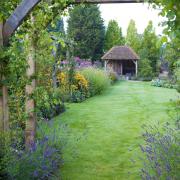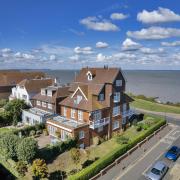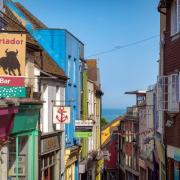Don’t be deterred by the salt and the sea – choose your plants carefully and it’s possible to create a garden that thrives no matter how close to the coast you are. Leigh talks to green-fingered experts for advice on what works best

Gardening by the sea does require careful planning, as you need to deal with a range of challenges, including salt spray and wind, but it also offers an opportunity to get creative and embrace the location. Climatic conditions vary around the coast, with Kent being one of the driest and sunniest parts of the British Isles. By choosing hardy, salt-tolerant plants, providing shelter and adding some quirky nautical pieces, you can have fun with coastal gardening. Think beyond the usual lawn with garden beds and embrace the unique visual elements of the coast. Get to know your microclimates, not only from how close you are to the sea, but also within your own garden. Create shelter with boundaries that filter the wind and salt; then find seaside-proof plants to create clumps and drifts. As with all gardening, aim to select the right plant for the right place, to suit the soil and aspect. Take a wander, look at what grows naturally by the seaside, such as tough grasses and sea kale, explore areas beyond the headlands and into the towns and villages, to discover what works well in local gardens as you move further inland.

Many coastal gardens lend themselves to a Mediterranean style, with their three main ingredients of rustic features, natural materials and drought-tolerant plants. Try some different looks using drought-resistant, low maintenance plants, for a casual vibe that is quite irresistible on long summer days and into the evening. In fact there are already many plants from the Mediterranean region that grow well in the UK, with our climate of warm, dry summers and mild winters -particularly here in the south -very suitable for a range of choices. Channel the essence with relaxing, informal spaces brimming with scented, textural combinations and rustic detailing, and play with the colours of the Med in your choices of floral accents, furnishings and containers. Mediterranean gardens are all about laidback outdoor living: lingering over al fresco meals with friends and family, taking a refreshing siesta, enlivening the senses with intoxicating scents and vibrant colours - all with the aim of simply spending time out in the garden for the sheer enjoyment of the space.

Be inspired by the lifestyle and culture of European Spain, Southern France, Italy and Greece. Ideas from these countries work well in our coastal Kent gardens, especially given climate change. It takes some thought and planning to create that artless, weathered atmosphere, with both structure and planting working together to set the scene. Gravel, shingle and warm-toned paving, terraced levels using stone walls or rockeries, terracotta pots filled with zingy flowers, climbers scrambling freely over walls and dappled shade from vine-clad rustic pergolas all contribute to the mood. Plants can be selected for fragrance, colour, year-long interest, their drought-tolerance and ease of care. Include architectural plants to add some height and drama, such as palms, cypress and yuccas. Water features, though not essential (after all, you've got the sea nearby), are a lovely way to add a shimmer, sound or break up the dry landscape. For a colour palette think of the cool blues of the sea, sun-kissed warm earthy tones, aged patinas, white-washed walls and splashes of reds or hot pink, backed by soft greys and silver.

Coastal gardens to visit
• Sandown Castle Community Garden, Deal, CT14 6NY
Colourful abundance on the seafront
• Kingsnorth Gardens, Folkestone, CT20 2QP
Ornamental town park, decorative bedding and shrubs
• Sunken Gardens, Westbrook, Margate, CT9 5EJ, thesunkengarden.co.uk
Community project, evolving garden with architectural planting
• The Pines Garden, St Margaret’s Bay, CT15 6DZ, baytrust.org.uk
Environmental educational charity, landscape garden
• Take a drive around Dungeness for the unique, windswept landscape and Prospect Cottage’s atmospheric garden, created by Derek Jarman (KL, July 2024) creativefolkestone.org.uk/prospect-cottage/

Get the look
• Provide windbreaks with hedges that filter and slow down the wind.
• Look around at native vegetation and see what grows well in your area.
• Cut out some ‘portholes’ in hedges to give views.
• Coastal gardens need to cope with everything from icy gales in winter to drying summer winds laden with salt, which scorches foliage.
• As well as plants to filter winds you can use living willow fences, chestnut picket fences with narrow gaps to allow wind through, or windbreak fencing mesh.
• Coastal plant choices often have tough, hairy or leathery leaves, as they protect the plant from moisture loss and salt damage.
• Look for botanical names with maritima or littoralis, meaning ‘of the shore’.
• Plant in late spring and summer to give plants time to establish before winter gales.
• Mulch and protect young plants with shingle, flint, grit or gravel – provides sharp drainage while conserving moisture at the roots.
• Soak plants and only water when really necessary, as this will encourage stronger roots.
• Add water gel crystals to containers.
• Use bright colours in the stronger light.
• Instead of lawns, use shingles or pebbles with patches of groundcovers.
• If you have a good windbreak you can use a wider palette of plants.
• Add nautical ornamentation – jetty timbers, lobster pots, anchor chain, driftwood.
• Use toughened glass panels for al fresco dining and relaxing areas, to protect from the winds without compromising views.
Top coastal plants
• Hedging and shrubs – Griselinia littoralis, Hebe salicifolia, Ulex europaeus ‘Flore Pleno’, Eleagnus ebbingei, Hippophae rhamnoides (sea buckthorn), Ilex aquifolium, Berberis, Crataegus monogyna, Rosa pimpinellifolia, Rosa rugosa, Photinia fraseri
• Trees and shrubs – Eucalyptus gunnii, Acer pseudoplatanus, Alnus glutinosa, Carpinus betulus, Acacia dealbata, pines, cordyline, cytisus, pyracantha, ceanothus, grevillea, cistus, olearia, Castanea sativa, Escallonia, Fuchsia magellanica, Euonymus japonicas, Potentilla fruiticosa, Perovskia
• Perennials – achillea, agapanthus, aubretia, Alchemilla mollis, Amaryllis belladonna, Armeria maritima, Crambe cordifolia, centranthus, crocosmia, delosperma (ice plant), echium, erigeron, eryngium (sea holly), gallardia, helianthemum, osteospermum, kniphofia, sedum, thyme, alyssum, gazania, Limonium platyphyllum (sea lavender), senecio, verbascum, helichrysum, geraniums, leucanthemum, libertia, rudbeckia, Stachys byzantina
• Annuals and half-hardy perennials – Amicia zygomeris, Anizoganthos, Antirrhinum, Cerinthe major, cosmos, Papaver somniferum, Californian poppy, calendula, anthemis, convolvulus, dianthus
• Grasses evoke the ocean, almost every one tolerates salt, make the breezy atmosphere a benefit as the sense of movement is their charm, so are wonderful to use - cortaderia, miscanthus, pennisetum, restio, festuca, helictotrichon, calamagrostis, carex, acorus
Did you know?
• The terms 'flotsam and jetsam', used to describe odds and ends found washed up on beaches, actually refer to specific types of marine debris – 'flotsam' (to float) for debris that wasn’t thrown over deliberately, often due to shipwrecks, found floating on the water; 'jetsam' (jettison) for debris deliberately thrown overboard by a crew of a ship in distress, to lighten the ship’s load, that then sinks and washes up ashore.
• Under marine law, flotsam can be claimed by the original owner, whereas jetsam becomes the property of the finder. You can also collect bits of driftwood, sea-worn glass, pieces of string, fishing floats, rusted metal etc. to upcycle, but any real treasure such as ancient coins should be reported to the district coroner.
• Don’t take stones or plants from the beach, and if you're after shells I would recommend using ones from scallops after you've enjoyed a home-cooked batch. For other items such as lobster pots, rope, or even old boats try eBay, reclamation yards and online neighbourh sites such as Nextdoor.co.uk.































